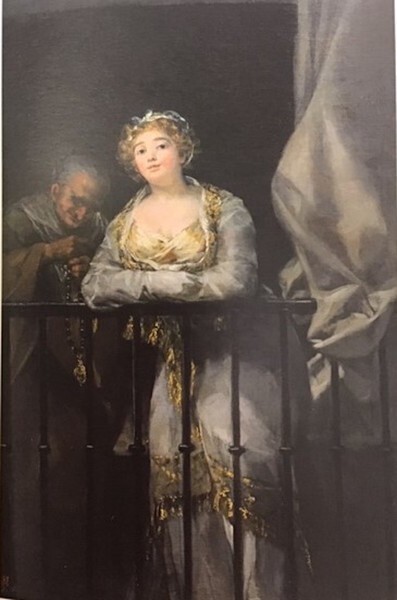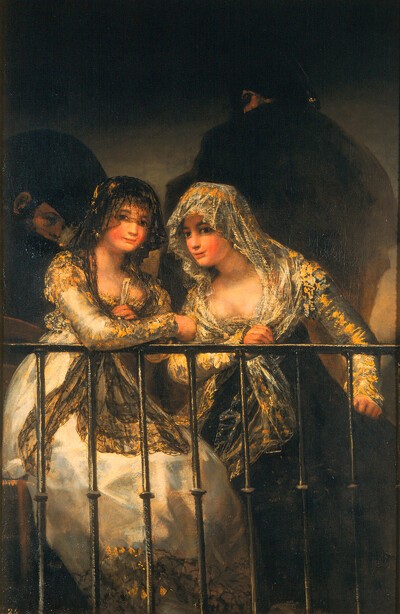- Cronología
- Ca. 1808 - 1812
- Ubicación
- Private collection
- Dimensiones
- 166 x 108 cm
- Técnica y soporte
- Oil on canvas
- Reconocimiento de la autoría de Goya
- Documented work
- Titular
- Private collection
- Ficha: realización/revisión
- 21 Apr 2010 / 01 Jun 2023
- Inventario
- -
- Otros títulos:
-
Celestina and her Daughter
X.24 (lower left-hand corner).
During the Spanish War of Independence, Goya produced some private works, including this one, Majas on a Balcony, Lazarillo of Tormes, and probably Time or Old Women.
The painting appears in the inventory drawn up of the belongings to be shared between Goya and his son Javier on the death of his wife in 1812 as one of the "two paintings of young women on a balcony with inventory number twenty-four, valued at 400 [reales], the other painting being Majas on a Balcony. The work was purchased from Javier Goya by Francisco de Acebal y Arratia, and later passed to his heir, Luis Mac-Crohon, and his collection in Madrid. It was acquired in 1942 by Juan March, passing in 1962 to his son Bartolomé March. It was sold to another private owner in 2003.
We are presented with the almost full-length portrayal of a beautiful young woman with blond hair who is leaning on the iron railing of a balcony, showing off her figure. She is wearing a grey gown with a gold edging, displaying a generous cleavage. On her left, further away from the railing, is an old woman with a mischievous look on her face who is holding a rosary while she looks for business. The right-hand side of the composition is closed off by a grey curtain, and the dark interior with no details or furniture, do not allow the viewer to see what kind of room it is.
The figure of the young woman is reminiscent of the maja Goya painted in the frescoes for the Chapel of San Antonio de la Florida in Madrid. She also resembles some figures in the Caprices series in which Goya also dealt with the subject of the prostitute and the procuress.
It has been suggested that the reappearance of these sensual young women in Goya's work during these years was perhaps motivated by his affair with the young Leocadia Weiss, and it is possible that the main figure in The Letter is her portrait.
The inscription marking this painting as the property of Javier Goya, "X 24", is no longer visible on the canvas, but was originally located on the lower left-hand corner.
-
Pinturas de GoyaMuseo Nacional del PradoMadrid1928consultant editor Fernando Álvarez de Sotomayor. From Apri to -May 1928cat. 16
-
Exposición conmemorativa del centenario de GoyaPalacio de OrienteMadrid1946organized by Patrimonio Nacional. June 1946cat. 9
-
cat. 82
-
El arte de GoyaMuseo de Arte Occidental de TokioTokyo1971from 16th 1971 to January 23th 1972. Exhibited also at the Kyoto Municipal Museum of Art, January 29th to March 15th 1972.cat. 39
-
Goya en las colecciones madrileñasMuseo Nacional del PradoMadrid1983consultant editor Enrique Lafuente Ferrari. From April 19th to June 20th 1983cat. 39
-
Goya y el espíritu de la IlustraciónMuseo Nacional del PradoMadrid1988from October 6th to December 18th 1988. Exhibited also at Museum of Fine Arts, Boston, January 18th to March 26th 1989; The Metropolitan Museum of Art, Nueva York, May 9th to July 16th 1989, Madrid curator Manuela B. Mena Marqués, scientific directors Alfonso E. Pérez Sánchez and Eleanor A. Sayrecat. 70
-
Francisco de Goya: Maleri, Tegning, GrafikkNasjonalgallerietOslo1996from 10th to April 14th 1996cat. 28
-
Goya en tiempos de guerraMuseo Nacional del PradoMadrid2008consultant editor Manuela B. Mena Marqués, from April 14th to July 13th 2008cat. 65
-
Expérience GoyaLille2021cat. 71
-
GoyaBasle2021p. 242
-
L'œuvre peint de Goya. 4 volsParís1928-1950vol. II, p. 283, cat. 536s
-
Goya en tiempos de guerraMadridMuseo Nacional del Prado2008pp. 248-251, cat. 65 y p. 253 (il.)


